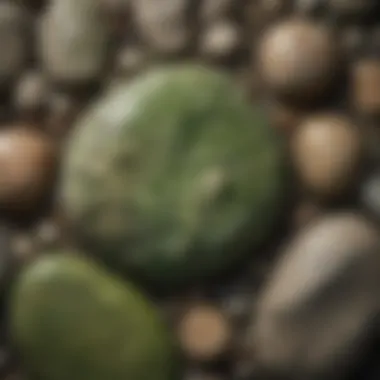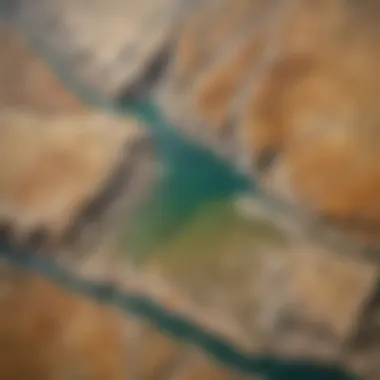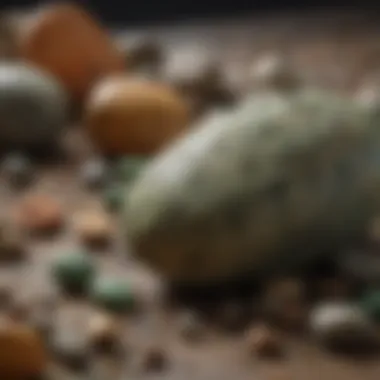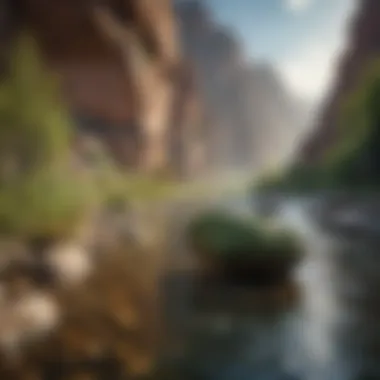Understanding Green River Rock: A Geological Marvel


Intro
Green River rock is a geological wonder that fascinates many. Known for its unique attributes and historical importance, this rock type has captivated both serious collectors and casual enthusiasts. Understanding the intricacies of Green River rock—from its origin to its various uses—is essential for anyone interested in geology and fossil hunting. This guide will explore identifying the rock and fossils associated with it, offer tips for collecting, preservation methods, and insights into its geological context.
Rock and Fossil Identification
Identifyng Green River rock and its fossil contents requires familiarity with the specific properties that make it stand out. The composition of Green River rock includes sedimentary features and unique fossil types that lay testament to its ancient origins.
Types of Rocks and Fossils
Green River rock predominantly contains limestones and shales, often rich with fossilized remains of various species. Common fossils include fish, insects, and plant debris from the Eocene epoch. The fossil record in these rocks is robust, suggesting an environment once teeming with life. Some notable rocks in this formation include Green River Formation, prominent in Wyoming, Colorado, and Utah.
Characteristics to Look For
When identifying these rocks and fossils, keep an eye on specific signs:
- Color: Green River rock often appears in shades of olive green or gray.
- Fossils: Articulated fish fossils and unique leaf impressions indicate the Eocene flora and fauna.
- Texture: A smooth, fine-grained texture is common, contrasting with coarse-grained counterparts.
Tools for Identification
A few tools can enhance your identification process:
- Hand Lens: To examine small details on fossil specimens.
- Geological Hammer: For breaking larger rocks without damaging fossils.
- Field Guides: Reference books specific to local geology are invaluable for ensuring accurate identification.
Collecting Tips and Techniques
Successfully collecting Green River rock requires strategy and technique. Understanding the environment will increase the likelihood of finding pristine specimens.
Best Practices for Collecting
- Know the Legal Requirements: Ensure you have the necessary permits, especially in protected areas.
- Leave No Trace: Be mindful of the environment and preserve its integrity for future geology enthusiasts.
Locating Prime Collecting Sites
If you are keen on exploring, certain areas are famous for their rich deposits:
- Fossil Butte National Monument, Wyoming: Renowned for its well-preserved fossil layers.
- Green River Formation in Utah: Home to a vast array of fossilized specimens.
How to Safely Extract Specimens
Care should be taken during extraction:
- Use proper tools to minimize damage to both the rock and fossils.
- Wear safety gear to protect against sharp tools and rocks.
Preservation and Display
Caring for found fossils or Green River rock involves skill and knowledge to ensure their longevity.
Techniques for Preserving Rocks and Fossils
Simple preservation techniques can increase the lifespan of your specimens:
- Use breathable storage materials to avoid moisture buildup.
- The application of an appropriate consolidant can strengthen fragile fossils without causing damage.
Proper Storage Methods
For long-term storage, consider:
- Cool, Dry Places: Store specimens in stable temperature environments.
- Archival Materials: Utilize acid-free boxes and straps for susceptibility protection.
Creative Display Ideas
Displaying your collection doesn't have to be dull:
- Create a shadow box that highlights an impressive specimen.
- Use clear acrylic displays to allow light exposure and enhance visibility.
Geological Insights


Understanding the geological context of Green River rock elevates appreciation for its formation and significance.
Geological Formations and Processes
The Green River Formation was deposited in ancient lake environments, revealing myriad ecological dynamics.
Historical Significance of Rocks and Fossils
Green River rocks narrate epochs long gone. The fossils extracted help elucidate understanding of prehistoric life and environmental shifts.
Notable Discoveries in the Field
Several key discoveries have shaped paleontology based on findings from this formation, significantly advancing our understanding of ancient aquatic ecosystems.
_
Intro to Green River Rock
Green River rock is a fascinating subject within geology, offering rich material for exploration. Understanding its importance lays foundations for deeper academic inquiry and practical applications. This section sets the stage for topics such as its unique properties, historical significance, and ecological implications.
Definition and Characteristics
Green River rock is often recognized for its unique hues and chemical makeup. Typically marked by tones of gray, green, and blue, it displays intricate patterns that have attracted geologists and collectors alike. The rock is primarily composed of a fine-grained limestone with rich organic origins, which contributes to its distinctive color and texture. The hardness of Green River rock stands as evidence of its resilience. When polished, it can develop a brilliant luster, making it appealing for use in decorative items. This material is not merely aesthetically significant; its diverse mineral composition points to varied origins, offering a glimpse into the environmental conditions at the time of its formation.
Historical Significance
The historical narrative of Green River rock is as captivating as its formation. This rock type is linked to the famous Green River Formation in Wyoming, Utah, and Colorado. Dating back to the Eocene epoch, approximately fifty million years ago, these deposits are crucial to understanding past biodiverse ecosystems. Fossils found interred within the layers of Green River rock provide key insights into prehistoric life. Artifacts made from Green River rock often tell stories about early human usage, suggesting a consciousness about aesthetic and practical applications that we continue to explore today. The inherent value of these rocks does not end with scientific curiosity; it also touches upon the economics involved in trade, collection, and craftsmanship, further enriching the ongoing human relationship with geological resources.
In summary, Green River rock embodies a unique blend of aesthetic charm, scientific intrigue, and historical depth.
Geological Formation of Green River Rock
Exploring the geological formation of Green River rock is crucial for understanding its character and diverse applications. This section outlines the processes that lead to the creation of this unique rock, detailing its evolution over time.
Origin and Age
The origins of Green River rock trace back to the formations found predominantly in the Green River Formation located in the western United States. This formation dates to the Eocene epoch, roughly 56 to 34 million years ago. The volcanic activity and sedimentation in ancient freshwater lakes contributed significantly to its genesis. These lakes filled with various sediments, providing an ideal condition for the enrichment of organic materials, which eventually transformed into the distinct stone we see today. Notably, the resulting rock, noted for its historic significance and visual appeal, displays the imprint of prehistoric life through fossils enclosed within it.
Environmental Conditions
When we discuss the environmental conditions that fostered the formation of Green River rock, we consider several key factors. The climate during the Eocene was mostly tropical, featuring stable temperatures and abundant rainfall. Such conditions were conducive to the growth of various types of flora. The lush ecosystem contributed organic material to the sediments in these lakes. Furthermore, fluctuations in water levels over millennia played a critical role in stratifying the rock. Depressive areas and shallow water zones promoted different sediment deposits characterizing the layered texture of Green River rock today.
Mineral Composition
The mineral composition of Green River rock is varied and rich, composed mainly of carbonate minerals like calcium carbonate. This primary component gives the stone its characteristic visual traits and texture. The presence of iron and magnesium compounds often creates hues ranging from deep greens to browns, making the rock aesthetically pleasing. Additionally, it contains organic materials that have long implicit significance in both geology and anthropology.
The fascinating nature of Green River rock lies not only in its beauty but also in its underlying geological narrative.
Understanding the geological formation of Green River rock provides essential insights for enthusiasts, collectors, and scientists alike. This knowledge enhances appreciation for the stone and informs their practices in collection and preservation.
Geographical Distribution
The geographical distribution of Green River rock is a critical aspect of its significance and appeal to collectors and enthusiasts. Understanding where this unique rock can be found allows for a deeper Appreciation of its historical and geological context. Furthermore, the distribution of Green River rock informs collectors about where to begin their hunt and helps in identifying various environmental influences that shaped its formation. Knowing the locations of significant deposits can aid collectors in understanding variations in color, texture, and other characteristics that define Green River rock.
Notable Locations
Green River rock is primarily found in the western United States, particularly in Utah, Wyoming, and Colorado. The most famous locations include:
- Green River Formation: This formation, mainly located in the Uinta Basin, is known for its rich fossil beds and expansive deposits of Green River rock. The region served as a vital prehistoric lake and provides a wealth of paleontological sites.
- Sweetwater County, Wyoming: Here, collectors can find stunning examples of Green River rock. The area's geology contributes to varied colors and textures, adding to the collectors' interest.
- Uintah County, Utah: The vibrant deposits of Green River rock can also be found here. This site is known for its intricate detail and clarity, which can appeal to serious rock enthusiasts.
Many people adventure to these places not only to collect but also to understand the region's geological past.
Global Presence
Though most prominent in the United States, Green River rock has drawn attention in various parts of the world. Its unique geological properties and historical importance make its study relevant on multiple continents. Some countries are known for hosting similar laminated sedimentary rocks, although they may not possess the same aesthetic qualities typical of green river rock.
- Canada: In regions like Alberta, rock enthusiasts find some varieties of sandstone that have analogous qualities to Green River rock.
- Europe: Certain sedimentary formations in countries like France and Germany offer a comparison due to their distinct mineral make-up, providing researchers insights on geological activities in a broader timeline.
- Asia: Stack horizons in places like China have been studied for their unique sedimentary layers, though they differ significantly from the Wyoming and Utah formations.


Understanding the global distribution of Green River rock helps establish not only local but also historical connections linking various geological phenomena across continents. Collectors benefit greatly from this comprehensive knowledge as it deepens their appreciation of rock gathering and geological exploration.
Applications of Green River Rock
The applications of Green River Rock are diverse and compel consideration across various disciplines, making this section critical in understanding its relevance. Green River Rock serves functional, artistic, and cultural purposes, with effects that go beyond mere common usage. The uniqueness of this geological specimen lies in its versatility. Each application reveals a new layer of significance, inviting enthusiasts and professionals alike to appreciate its many facets.
Cultural Significance
Green River Rock is steeped in cultural history, with significant ties to the communities that have historically interacted with it. Tribes in the region, particularly Native American cultures, have used these stones in various ways, from tools to symbolic artifacts.
Today, contemporary artists and craftsmen emphasize the cultural heritage embodied in these rocks. Many pieces integrate Green River Rock to reflect the ethos of sustainability and locality, while also paying homage to their origins.
Educated collectors and enthusiasts not only seek Natural specimens but also treasure their narratives. This connection between culture and rock elevates the status of Green River Rock beyond mineral collection to be regarded as living history. Heathens old folklore associated Green River Rock with fortitude, urging a respect for nature’s resources.
Uses in Art and Craft
Green River Rock plays a crucial role in the arts and crafts industry. Artistically, it offers wherw variety of tones and textures that can enhance various projects. Its aesthetic appeal has been recognized by sculptors and jewelers alike. Artwork display diversity, ranging from intricate carvings to elegantly polished stones used in jewelry.
Enthusiasts often partake in workshops focused on stone craft, where Green River Rock is a favored material due to its adaptability. This engagement pushes the boundaries of creativity while ensuring appreciation for geological uniqueness. Furthermore, the embedding of such acclaimed materials can boost market value for artisans, emphasizing social value.
It is not uncommon to see art pieces inspired by or directly incorporating Green River Rock in galleries, indicating its established presence in the art community.
Construction Materials
Green River Rock’s properties make it a prudent choice in construction and landscaping. It is both robust and resilient, vital for structural integrity.
When utilized in construction, it enhances aesthetics illuminating the architectural fragmentation and creating visually stimulating forms. Often used in decorative walls or pathways, it serves both functional and artistic objectives. Moreover, builders value its natural durability, resisting various environmental factors.
There are other practical implementations as well. Green River Rock acts well as a substrate in landscaping projects, contributing to soil stability while promoting drainage - an intrinsic counter to erosion. One may frequently observe its use in commercial construction or simple backyard settings, displaying its adaptability to various environments.
Collecting Green River Rock
Collecting Green River rock is a discipline that combines passion, knowledge, and a sense of adventure. For enthusiasts, these unique rocks possess more than just aesthetic value; they are repositories of history and geological phenomena. When scientists study Green River rock, they gain insights into ancient environments and the climate of different geological periods. This article section aims to guide collectors, shed light on significant elements of this practice, and discuss key benefits and considerations.
Tips for Collectors
Research Locations: Expanding your knowledge on areas rich in Green River rock can enhance your collecting experience. Places like Wyoming, Utah, and Colorado have regions where these rocks are prevalent.
Permits and Regulations: Understand the legalities of collecting rocks in different jurisdictions. Some areas require permits, while others may bound off-limits locations entirely.
Tools and Equipment: Consider using tools appropriate for safe collection. Items like a rock hammer, durable gloves, and eye protection can enhance both safety and efficiency during your hunt.
Documentation: Take notes during the process, including specific sites, rock types, and any co-collected geological samples. This record will serve as a valuable contribution to your collection's history.
Sustainability: When collecting, consider the ecological impact. Collect responsibly, leaving enough rocks for others and ensuring the preservation of the environment.
Preservation Techniques
Proper preservation is vital for maintaining the integrity and beauty of collected Green River rock. Instilling good practices can significantly enhance your collection's longevity.
Drying and Cleaning: Initially, clean your rocks gently using brushes and water. It’s essential to remove aiy excessive dirt and debris but handle them with caution to avoid damage.
Storing: Choose storage options that prevent scratching and accidental damage. Fabric bags or padded boxes can be ideal for preventing wear during storage.
Display: For displaying your collection, select a place that minimizes moisture and turbulent changes in temperature. This conscious selection safeguards the rock's natural look.
Collecting Green River rock not only brings joy, but also insights into the larger canvas of geological history.
By employing these tips and techniques, collectors can enhance their experience and preserve the beauty of Green River rock for years to come.
Ecological Implications
The ecological implications of Green River rock provide essential insights into how this geological feature interacts with its surrounding environment. Understanding these implications can aid in appreciating both the significance of the rock itself and the stability of local ecosystems where it is found.
Impact on Local Ecosystems
Green River rock and its presence in specific geographical areas directly influence local ecosystems. Here are a few noteworthy impacts:


- Habitat Creation: The unique compositions and formations of Green River rock contribute to habitat diversity. Certain organisms utilize the rock as a substrate, providing shelter and breeding sites. This can lead to increased biodiversity as various species thrive in the unique terrains created by the rock's presence.
- Nutrient Cycling: Rocks can affect soil formation over time. The gradual breakdown of Green River rock contributes minerals to the surrounding soil, enriching it. This in turn supports plant growth and impacts the types of vegetation that can thrive in an area.
- Water Regulation: There is often a connection between geology and hydrology. Green River rock can influence the flow and filtration of water in local watersheds. This behavior affects not only the immediate plant life but also aquatic habitats, depending on runoff dynamics.
Understanding these aspects shows the critical role of Green River rock in maintaining ecological balance. Its existence is more than just a geological phenomenon; it is a key player in sustaining local environments.
The reliance of ecosystems on geological features underscores the intricate relationships present in nature.
Conservation Efforts
Conservation practices in areas housing Green River rock serve several vital functions. They maintain ecological integrity and ensure that this geological resource remains available for both nature and study. Several efforts focus on conservation:
- Protected Areas: Establishing protected regions limits harmful human activities that might damage rock formations. Creating designated sites for geological research helps safeguard both the rock and the surrounding ecosystems.
- Permitting Systems: Implementing strict permitting processes for collecting activities ensures sustainable practices. These rules can mitigate over-harvesting and promote responsible collecting among enthusiasts and academics alike.
- Educational Programs: Raising awareness through educational initiatives targets not only the importance of Green River rock but also its broader ecological context. Programs for schools, universities, and local communities can foster a range of values regarding geological and ecological conservation.
- Restoration Projects: Revegetation and stabilization initiatives are critical in areas that have suffered ecological deformation due to over-collection of rock. Encouraging the natural recovery of these ecosystems mends the local habitat, reinstating favorable conditions for biodiversity.
Together, efforts focused on these conservation strategies aid in maintaining the ecological vitality of regions impacted by Green River rock harvesting, benefiting both humankind and the intricate web of life this rock supports.
Challenges in Harvesting Green River Rock
Harvesting Green River Rock comes with its own unique set of challenges. Understanding these challenges is crucial for anyone interested in this remarkable geological resource. These issues span a broad spectrum, including legal and ethical considerations as well as significant environmental impacts. Addressing these factors ensures responsible harvesting, promoting sustainable practices while protecting the integrity of geological formations.
Legal and Ethical Considerations
The legal landscape surrounding the collection and harvesting of Green River Rock can be intricate. Regulations vary widely by location, reflecting the value of this rock within various jurisdictions. First and foremost, collectors should fully understand the legal implications that come with collecting their sought-after specimens. Often, extensive lists of protected areas may include formations containing Green River Rock, making unauthorized removal illegal. Violating local laws can result in hefty fines and legal repercussions.
Ethics play a key role as well. Many collectors and enthusiasts advocate for responsible collecting practices, focusing on minimizing harm to the environment. Developing guidelines that combine respecting natural habitats with the desire to add to personal collections can be beneficial. Moreover, reaching out to environmental bodies for certification of practices often enhances the credibility of collectors. A heightened awareness of ethical considerations is essential in fostering a community focused on connecting human interests with preserving geological wonders.
Environmental Concerns
Harvesting Green River Rock can impose considerable strain on local environments. The natural sedimentary layers often govern regional ecosystems, which can be significantly disrupted by extraction activities. Physical disturbances like rock removal can lead to erosion, habitat destruction, and even pollution in nearby water sources. Preserve these delicate relationships is fundamental for maintaining biodiversity and ecological balance.
Further complicating the scenario are possible aesthetic impacts, as removing significant volumes of rock can alter landscapes profoundly. Not only does this change threaten intrinsic beauty, it can have series implications for flora and fauna relying on these environments. As collectors, there exists a responsibility to ensure that practices do not result in long-term damage.
Ultimately, balancing the pursuit of individual collections with the need for environmental stewardship creates an ongoing conversation within the geological community. Understanding and recognizing these challenges ensures that endeavors to harvest Green River Rock not only satisfy personal interests but also safeguard ecological health and longevity.
In pursuing geological treasures, it remains vital to weigh the collective and personal responsibilities that come with such actions.
Future of Green River Rock
Emerging Trends
As the geological hobby evolves, the interest in materials like Green River rock has shown significant growth. Collectors and enthusiasts are looking for unique pieces that can enhance their collections while also providing insight into the Earth's history.
Today, sustainability has become the buzzword in collection practices. Collectors are increasingly interested in how Green River rock can be collected responsibly. Ethical sourcing is a major consideration, ensuring that rock availability does not jeopardize local ecosystems. In particular, emerging trends in environmentally friendly collection methods are starting to dominate discussions in collector forums.
Technology also plays a role in the growth of Green River rock’s appeal.
- Online Communities: Websites such as Reddit and Facebook have groups dedicated specifically to this subject. Members share experiences, tips, and locations where these rocks can be found, fostering a sense of community for both new and veteran collectors.
- 3D Printing: Though somewhat controversial, some enthusiasts are exploring the possibility of creating accurate replicas of Green River rocks via 3D printing technology. This facilitates education without disturbing the environment.
Research and Development
The future of Green River rock also relies on advances in research and efforts in academia. Scientists are exploring its physical and chemical properties in greater depth. The scientific inquiries dive into the potential industries that could use Green River rock in innovative ways, from its geological significance to inventive construction methods.
Highlighted areas of focus include:
- Sustainable Mining Practices: Research aims to explore how mining techniques can minimize the ecological footprint.
- Preservation Techology: Safe ways to store Green River rocks without damaging their structure or appearance are in focus. Encouraging knowledge sharing among collectors about preservation adds to the development of best practices.
Research collaboration often occurs at institutions like universities, pushing the frontiers of geology while building important bridges with the collector community.
In an age where geological studies are gaining importance for understanding climate change, Green River rock contributes valuable insights into our planet's past. The protection and responsible management of these resources ensures our future engagement with this unique geological material.
Sustainability and ethical practices will be fundamental to the advancement of the Green River rock community.
Culmination
The conclusion section serves a pivotal role in reinforcing the significance of Green River rock as explored throughout the article. It synthesizes essential insights regarding the geological, ecological, and cultural facets of this fascinating mineral. By summarizing the intricate connections between Green River rock and its various applications, collectors and enthusiasts can appreciate the deeper implications of their interest in this unique geological specimen.
An informed understanding of specialized terminology, geological formation processes, and ecological impacts enhance collectors' knowledge and depth appreciation. Knowing where and how to responsibly collect Green River rock supports environmental sustainability and conservation efforts, which are, indeed, critical in today's world. Beyond enjoyment, collectors gain knowledge that encourages them to be the stewards of these irreplaceable natural resources.
Summary of Key Points
- Geological Formation: Green River rock originates from very specific ancient lake environments, giving it distinct characteristics that are unique to the areas of formation.
- Cultural and Artful Uses: This rock has significant applications in art and craft, adding historical richness to every carved piece or decorative function.
- Environmental and Ecological Relationships: Understanding the reactive shifts within ecosystems helps collectors curate practices that do not harm the local biodiversity.
- Legal Considerations: Being aware of the regulations related to collecting Green River rock ensures that the practice is both ethical and legal, promoting responsible sourcing within ecological constraints.
- Future Trends: Continuous research expands our understanding of the mineral, leading to new applications and creative pursuits in art and construction.
Final Thoughts
In summary, Green River rock is not just a geological phenomenon. Its beauty and intrinsic value merit an in-depth comprehension that encompasses various dimensions, from its rich history to its practical uses today. For rock and fossil collectors, engaging with this material isn't just about aesthetics; it's also about fostering a sense of responsibility towards the environment and cultural preservation. The intriguing processes that shaped Green River rock offer every individual an opportunity for education and a chance to promote conservation principles.
Collectors are encouraged to recognize the broader significance of their endeavors. Taking time to appreciate, respect, and protect the natural sources of Green River rock ensures that it remains a cherished aspect of geology and art for future generations. As learning and exploration continue, there will always be a depth of knowledge waiting to be uncovered with each specimen.







